Introduction
In the fast-paced world of finance, staying one step ahead of market volatility is crucial for businesses to thrive. One powerful tool that enables financial leaders to navigate uncertainties and seize opportunities is the 12-month rolling forecast. Unlike traditional static annual budgets, this dynamic forecasting method incorporates predictive analytics and business intelligence to provide a continuous, value-driven update mechanism.
By focusing on key data points and renewing calculations monthly, the rolling forecast offers a clear vantage point to discern sales and revenue trajectories. But it's not just about number-crunching; it's about constructing a narrative of your business's journey, informed by client feedback, employee performance, and market currents. In this article, we will explore the benefits of a 12-month rolling forecast and outline practical steps to create an effective forecasting strategy that aligns with your organization's goals.
So let's dive in and discover how you can harness the power of predictive insights to drive tangible business outcomes.
Understanding the Benefits of a 12-Month Rolling Forecast
The 12-month rolling projection stands as a dynamic beacon in the financial landscape, shedding light on prospective performance and ensuring businesses remain agile in the face of market volatility. With the power of predictive analytics and business intelligence synergizing, this forecasting method transcends the static nature of an annual budget by incorporating a continuous, value-driven update mechanism. It's a deliberate pivot from focusing solely on accuracy, towards embracing the foresight to navigate risks, seize emerging opportunities, and synchronize strategic endeavors with operational resources.
In the realm of trend analysis, the rolling projection emerges as a practical statistical ally. By focusing on a select array of data points and renewing its calculation with each passing month, it provides a clear vantage point to discern sales and revenue trajectories. This is not just about number-crunching; it's about constructing a narrative of your business’s journey, informed by client feedback, employee performance, and market currents. Financial leaders are recognizing that the true merit of a forecast lies in its ability to steer toward tangible benefits—be they cost reductions, revenue enhancements, or the optimized allocation of time and resources.
This monetary tool's effectiveness is highlighted by the insights obtained from economic specialists and business strategists alike. For example, the Blue Chip Economic Indicators collect forecasts from over fifty economists across prominent institutions, providing a consensus that serves as a guiding light for planning. Furthermore, embracing such tools does not necessitate advanced mathematics or complex algorithms; basic statistical analysis and business metrics can unlock significant predictive power. As one expert puts it, the annual budgeting process is the perfect time for alignment on strategy, setting the stage for impactful decisions and growth initiatives in the year ahead.
Step 1: Gather and Prepare Historical Data
Developing a strong 12-month rolling prediction requires a thorough analysis of past information, including financial records, sales metrics, expenses, and other relevant factors from the previous year. This comprehensive analysis is not merely about tracing patterns and seasonal fluctuations; it's about grasping the narrative behind the numbers. It involves identifying the underlying factors influencing your market's dynamics—demand, market size, economic indicators, and location—to create predictions that align with real-world scenarios.
By carefully analyzing this information, you can identify the consumer behaviors and economic conditions that define your business landscape. For example, recognizing how consumer spending increases during particular seasons, such as the Thanksgiving holiday period, informs not only your prediction but also your strategic approach. It's about leveraging this intelligence to anticipate market shifts and position your business for optimal performance. The interplay of diverse data sets, from demographic insights to complex economic documents, equips you with the foresight needed for forward-thinking monetary planning.
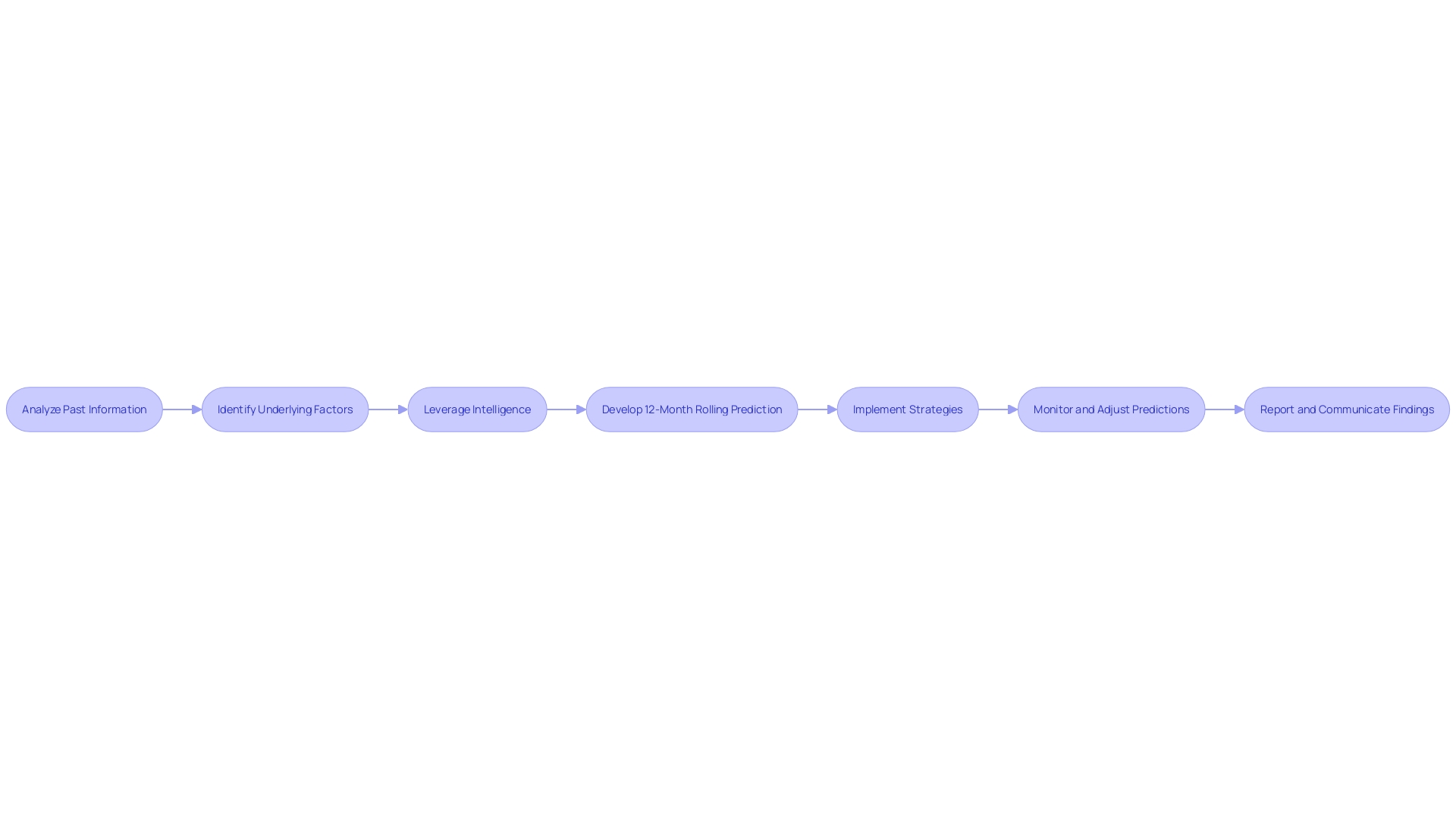
Step 2: Set the Forecasting Period
Determining the time frame for a 12-month rolling projection is a crucial step in guaranteeing its efficiency as a financial planning instrument. Instead of being confined to a static annual prediction, rolling forecasts allow for continuous updates, reflecting current market conditions and operational realities. Such an approach aligns with the observations by the Institute for Supply Management® (ISM®), which highlights the significance of dynamic prediction in driving value and competitive advantage.
To tailor the forecast period to your organization's unique demands, it's essential to consider the nature of your operations. For instance, companies like those involved in on-premise product installations for critical infrastructure, as highlighted in our case studies, may prefer less frequent updates due to the nature of their business. On the other hand, utilizing Monte Carlo simulations can provide insights into feature completion timelines, aiding in the coordination of product deliveries, even those as logistically complex as shipping.
The factors influencing the selection of time period extend beyond operational considerations. Time series prediction, a technique that depends on patterns in historical information, is crucial in anticipating future trends and demands. This is especially important in industries with clear cyclicality or seasonality, where the ISM®'s annual adjustments to the seasonal factors used in its PMI® reports demonstrate the necessity for up-to-date and seasonally adjusted prediction models.
Moreover, using predictive analytics, which combines past data with machine learning, provides a more detailed and up-to-date viewpoint on prediction. This approach is increasingly favored over conventional models for its speed and precision in capturing market movements and consumer behavior, as evidenced by our statistics indicating the competitive advantage AI prediction offers.
In the end, when deciding the time frame for your 12-month ongoing prediction, it's crucial to consider these factors thoroughly. Taking this action guarantees that the chosen time frame is not only consistent but also adaptive to the rapidly changing business landscape, resulting in more informed and strategic monetary decisions.
Step 3: Determine Drivers for Each Line Item in the Forecast
Identifying the main factors influencing each projected line item is crucial for developing an accurate rolling prediction. These drivers are essentially the variables that have a direct influence on the financial metrics. Consider a sales projection for example; the influencing factors may vary from market demand and pricing strategy to the extent of promotional activities. Acknowledging and grasping these drivers enables you to shape more grounded and realistic projections. This section will assist you in identifying these factors and seamlessly integrating them into your ongoing prediction.
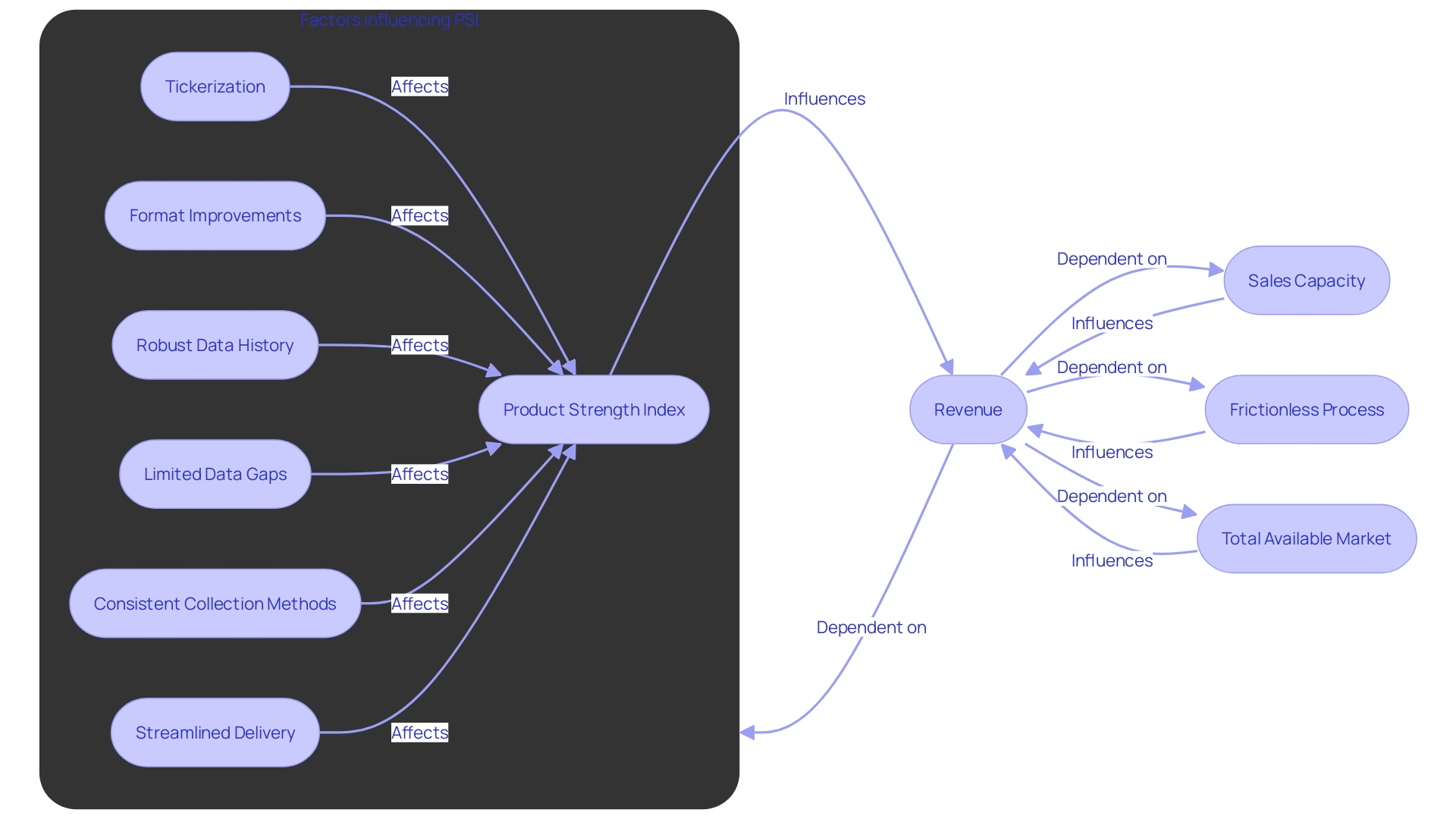
Step 4: Choose a Forecasting Method
Choosing the appropriate method for rolling forecasts is similar to selecting the best navigation tools for a voyage; the success of the journey depends on it. Forecasting techniques span a wide spectrum, from the straightforward to the complex. The selection of method should be customized to your company's distinctive characteristics, including the type of the sector, historical information availability, and the complexities of the variables in question.
Time series prediction stands out as an integral component in various sectors, including finance and manufacturing, where it serves as a cornerstone for predicting future demands and sales figures. This analysis technique employs methods like ARIMA, Exponential Smoothing, and Seasonal Decomposition to analyze historical information, allowing companies to effectively manage their inventories, improve supply chain performance, and make informed choices in finance and marketing.
In the field of economic research, dynamic factor models and nowcasting have gained attention for their capacity to offer early estimates of economic conditions, which are continuously improved with the release of new macroeconomic information. These advanced techniques represent the forefront of prediction, showcasing the development of the field and its worldwide application.
Furthermore, the introduction of novel techniques like quantum derivatives and generative modeling in areas such as probability and machine learning highlights the swift advancement in data analysis and prediction.
The practical application of these prediction methods is not without challenges. The prediction process is significantly distinct from standard regression analysis due to several contributing factors. Recognizing these challenges, it's crucial to utilize accuracy metrics to measure the performance of your prediction model, thereby ensuring its dependability and the validity of subsequent decisions.
In the end, the core of predicting goes beyond mere accuracy; it is about creating value and producing impact. As we explore the intricacies of prediction, we acknowledge that generating concrete advantages, whether in monetary profits or operational improvements, is the ultimate goal.
Fundamentally, your selection of prediction technique should not only demonstrate a profound comprehension of the accessible methods but also a recognition of their strategic consequences, guaranteeing that your continuous projection matches the overall objectives of your organization.
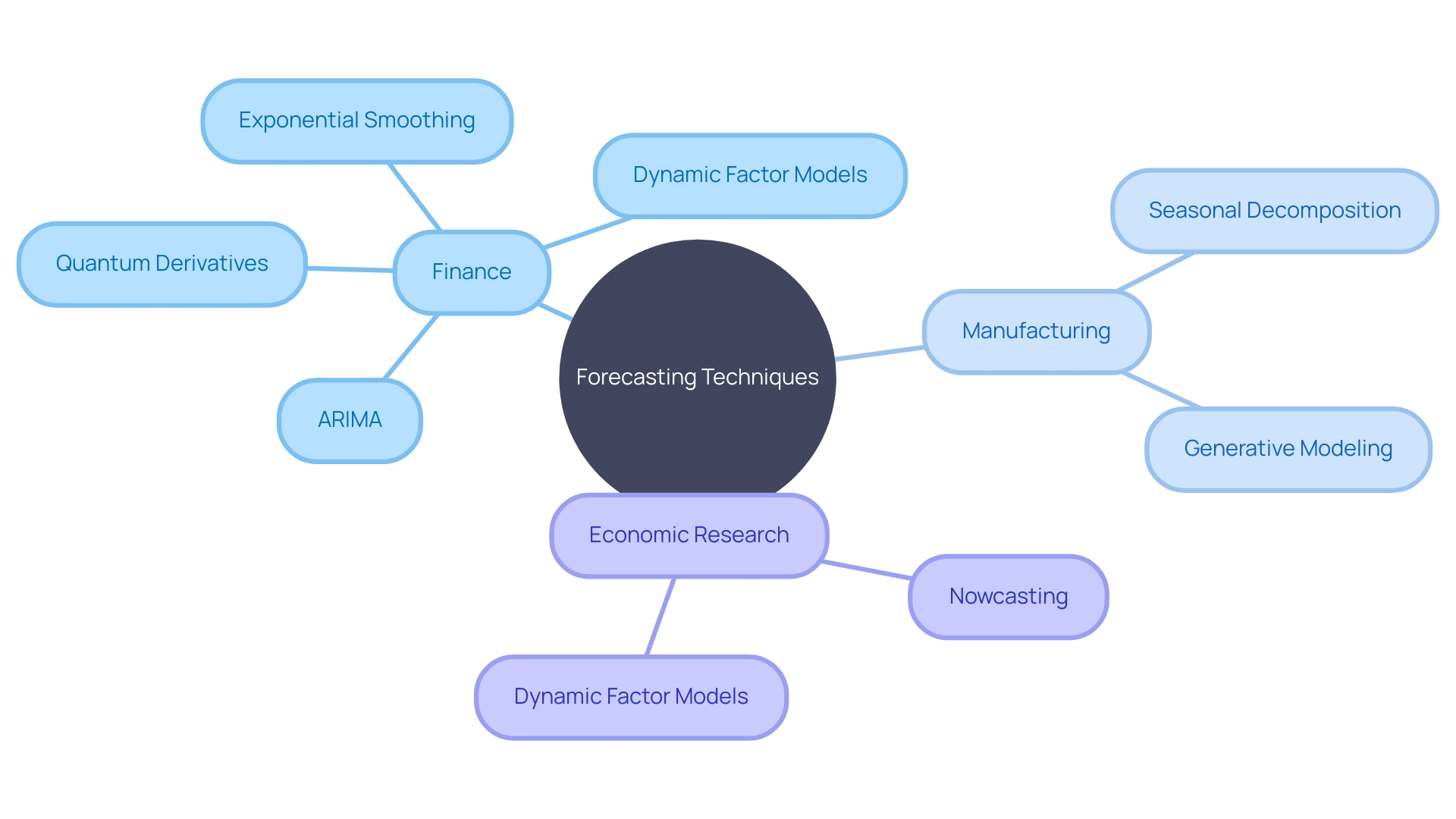
Step 5: Apply the Chosen Forecasting Method
Utilizing past information and analytical techniques, like ARIMA, Exponential Smoothing, or Seasonal Decomposition, is crucial for creating a 12-month rolling prediction. The accuracy of these predictions is crucial for adapting stock levels, optimizing supply chains, and making informed decisions in finance and marketing to stay competitive. Research, such as those conducted by Neumark and Wascher, Phillips and Nordlund, and Owyang and Vermann, emphasize the difficulties in predicting precision caused by biases and systematic revisions in information such as payroll employment statistics. Nevertheless, adopting predictive analytics, which employs AI to recognize patterns in information and anticipate future trends, and incorporating it with business intelligence can greatly enhance prediction precision. Through the creation of dashboards and reports, business intelligence enables the interpretation of intricate information, facilitating a decision-making process driven by information. Precise predictions are not only about number calculations; they symbolize the culmination of strong information analysis and the strategic employment of anticipatory tools to direct future business strategies.
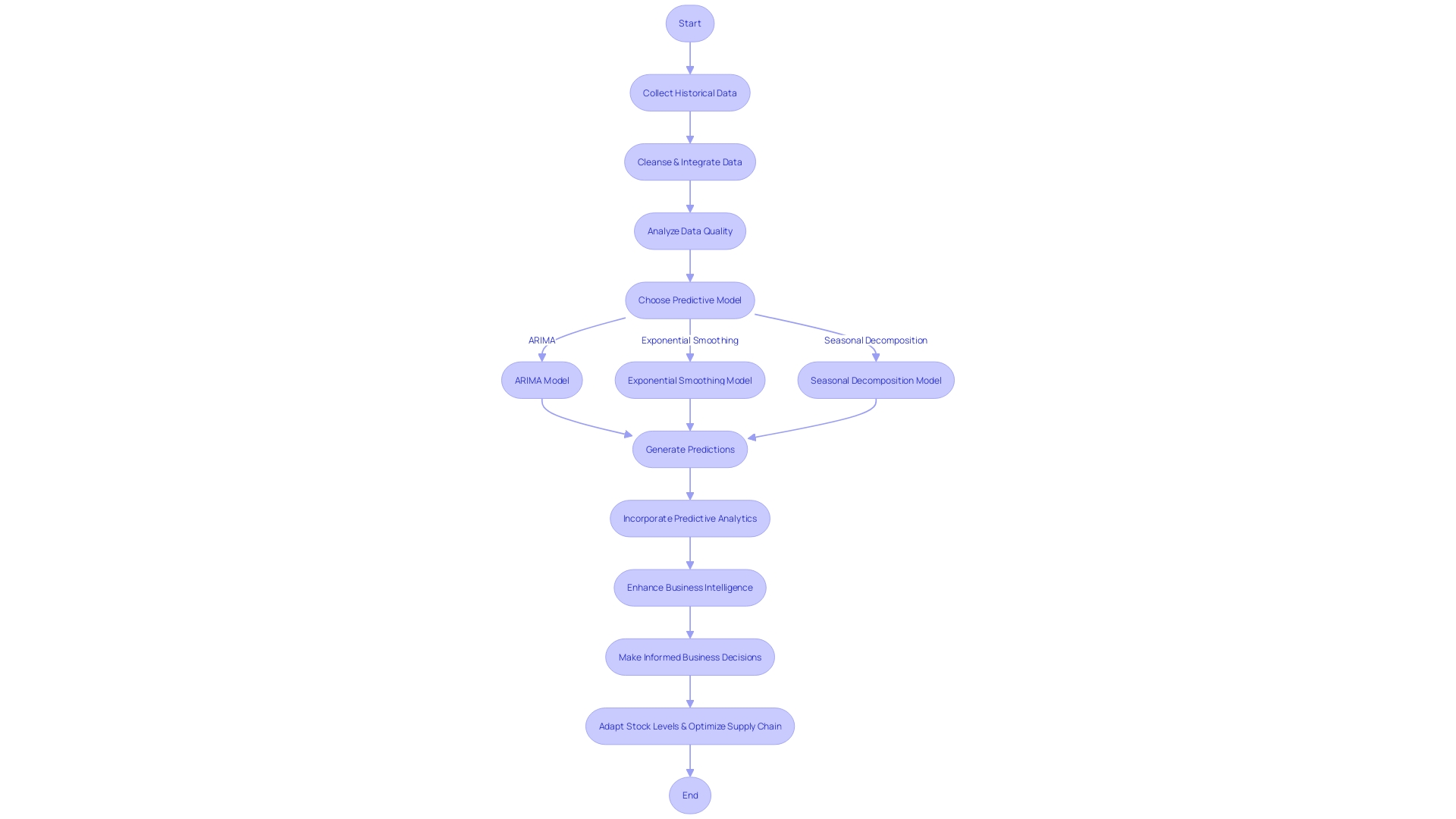
Step 6: Create a Rolling Forecast Template in Excel
Developing a successful 12-month rolling prediction in Excel necessitates more than just past information; it requires a flexible approach that can adjust to real-world events and trends. As economic conditions shift and unforeseen events occur, your forecasting model must be robust enough to handle these changes. Using the most recent features of Excel, like synchronizing form information and inserting images into cells, can improve the accuracy and functionality of your forecast.
When creating your Excel template, take into account integrating real-time information and AI-driven insights to remain ahead of market trends and events that could affect your projections. With tools like PivotTables, you can analyze and visualize transaction records, gaining deeper insights into sales patterns and customer behavior.
Embrace trend analysis with rolling averages to predict future performance by focusing on specific information points. This method allows you to update your forecast with new data while phasing out the oldest, ensuring a current view of your business trajectory.
Keep in mind, the process of making predictions is not just about foreseeing the future; it's about providing information for strategic decisions. By combining the power of Excel with the best practices in prediction, you can create a dynamic template that serves as a reliable foundation for managing your company's financial direction.

Step 7: Use Excel's Forecast Functions (e.g., FORECAST.ETS)
Excel's suite of forecasting functions, such as FORECAST.ETS, represents the convergence of user-friendly interface and sophisticated predictive analytics. Using sophisticated algorithms, these tools analyze past information to predict future trends and patterns. By comprehending subtleties like seasonal changes, they offer a strong basis for developing continuously updated 12-month predictions that adjust dynamically to fresh information. Integrating such functions into your projection template not only streamlines the process but also enhances the accuracy of your estimations, ensuring you can anticipate and plan for monetary results with greater confidence.

Step 8: Integrate Actuals, Budget, and Forecast for a Comprehensive View
For a thorough examination of performance in terms of money, combining real results, budget, and projected information is essential. By juxtaposing actual outcomes against budgeted goals and projections, differences become apparent, offering an opportunity to delve into causative factors and inform tactical revisions. This approach echoes the principle of integrated reporting, where strategy, governance, and performance are communicated in the context of the organization's external environment.
According to the International Accounting Standards Board (IASB), there is significant diversity in how over 60% of companies report operating profit, indicating the importance of a standardized framework for analysis. Incorporating monetary information aids in bringing together these distinct reporting methods, offering a more transparent outlook on fiscal well-being and backing knowledgeable decision-making.
A budget acts as a monetary guide for a specified duration, while prediction utilizes past data to anticipate future business performance. These tools for managing money are interdependent; predicting not only helps in establishing the initial budget but also plays a crucial part in monitoring progress. The decision-making process starts with identifying the forecast's purpose, followed by collecting statements and selecting suitable forecasting methods. The gathered information is the examined to guide the economic direction of the company.
The modern financial landscape requires flexibility in analysis, as highlighted by a quote from a Federal Open Market Committee (FOMC) member, emphasizing the challenge of traditional measurement approaches during rapid economic shifts. The integration of real-time information, advanced analytics, and expertise in data science enhances the capability to adapt to such changes.
In practice, this integration translates to establishing a culture that embraces new information types in investment decision-making, as exemplified by Stage 1 of the cultural change process. This stage calls for an overhaul in traditional approaches, necessitating cross-functional collaboration and a sustained commitment to the incorporation of alternative data.
Adopting an integrated approach to reporting goes beyond mere compliance; it strategically aligns with the goal of preserving or enhancing organizational value over time. As CFOs navigate through intricate financial landscapes, the amalgamation of actuals, budgets, and projections into a single, coherent framework is not just advantageous—it's imperative for steering organizations towards sustainable growth.
Step 9: Update and Refine the Forecast Regularly
To maintain the efficacy of a 12-month rolling forecast, it is imperative to engage in regular updates and refinements. This critical exercise involves a thorough analysis of the underlying drivers, an evaluation of projection accuracy, and the integration of new data or shifts in market dynamics. By committing to this ongoing process, businesses can respond swiftly to emerging trends, steer through changes with agility, and solidify the attainment of their financial objectives. We'll explore the importance of continuous improvements and guide you through the process to effectively enhance your rolling projection.
The ever-changing nature of predictions requires carefulness and a willingness to adjust. 'Research, like the ones conducted by Neumark and Wascher, demonstrate that initial information can frequently be deceptive, emphasizing the need to adjust predictions with fresh evidence.'. The employment sector, specifically, has seen such challenges, with biases in early estimates necessitating subsequent adjustments. A continuous prediction, therefore, is not unlike; it flourishes on readjustment based on the most recent benchmark information and insights.
Furthermore, the incorporation of different data sources can significantly improve the precision and dependability of predictions. This multi-faceted approach is exemplified by the evolving employment estimation methods, where reconciling differing measures has proven beneficial. Similarly, when developing future projections, integrating various data sources can lead to a stronger financial perspective.
In the context of New York City's economy, the recent shift from a Wall Street-centric model to a burgeoning tech sector underscores the importance of adaptable forecasting. As economic pillars fluctuate, so too must the projections that inform fiscal strategies. In the same way, by looking at supply management, the Institute for Supply Management® emphasizes the significance of improving practices to create value - a philosophy that corresponds to the continuous improvement of rolling predictions.
Lastly, including seasonal adjustments, as implemented by ISM® for its PMI® Report On Business®, demonstrates the importance of refining predictions to consider predictable variances. Such adjustments ensure that the data reflects a clear picture, devoid of distortions caused by seasonal patterns.
In summary, the continuous refinement of a 12-month rolling forecast is not just a best practice — it's a strategic imperative that captures the dynamism of today's business environment and safeguards against the pitfalls of static planning.
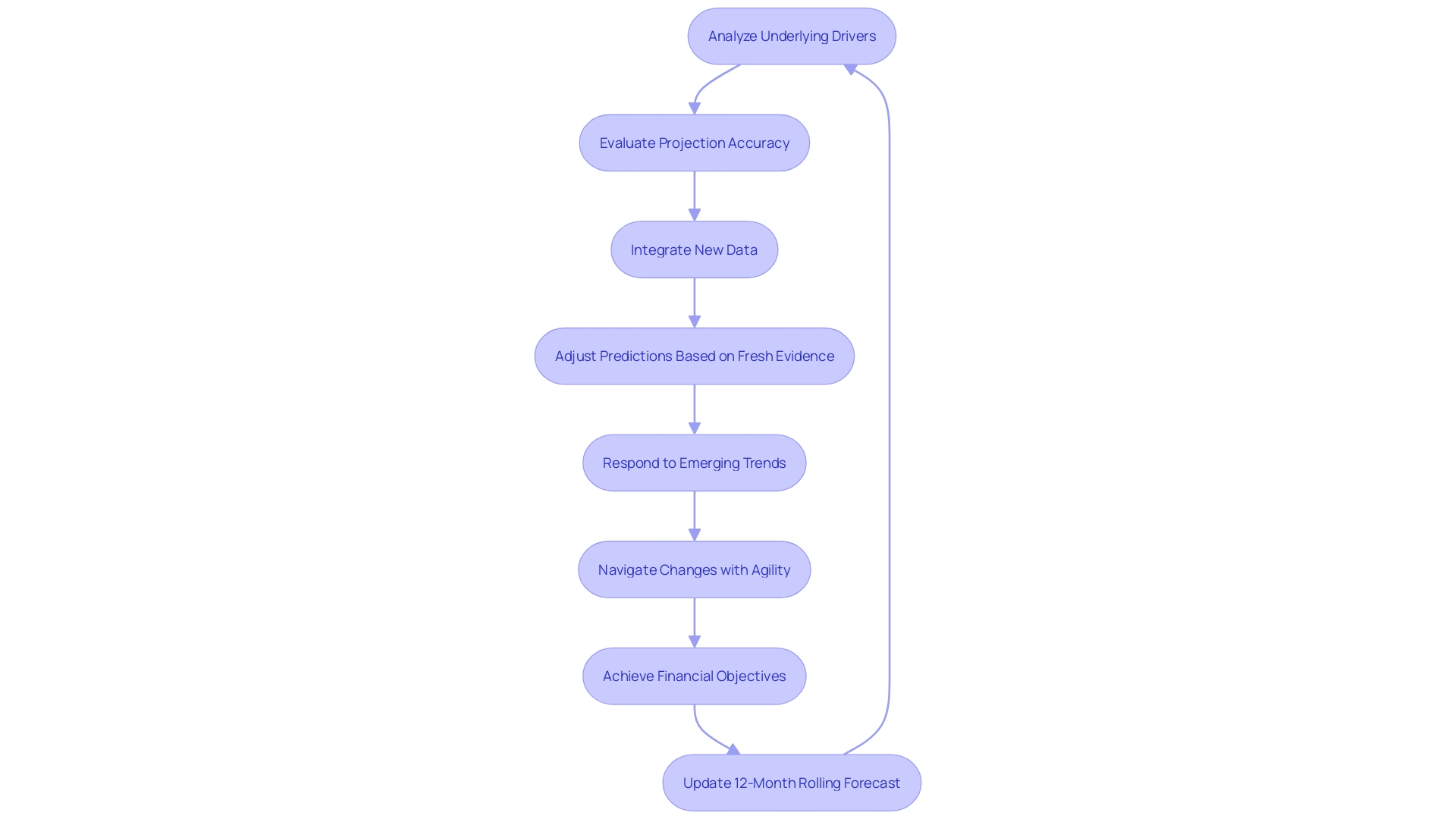
Conclusion
In conclusion, the 12-month rolling forecast is a powerful tool for financial leaders to navigate market volatility and drive tangible business outcomes. By incorporating predictive analytics and business intelligence, this dynamic forecasting method provides a continuous update mechanism that goes beyond traditional static budgets.
To create an effective forecasting strategy, gather and prepare historical data to understand the underlying factors driving market dynamics. This intelligence helps anticipate shifts and position your business for optimal performance.
Setting the forecasting period is crucial, considering the nature of your operations and the need for up-to-date and seasonally adjusted forecasting models. Choosing the right forecasting method, tailored to your business's unique characteristics, is essential for accurate projections and strategic implications.
Creating a rolling forecast template in Excel requires a dynamic approach that can adapt to real-world events and trends. Excel's forecasting functions, such as FORECAST.ETS, enhance the accuracy and functionality of your forecast.
Integrating actuals, budget, and forecast data is crucial for a comprehensive view of financial performance. By analyzing these elements, differences become apparent, offering an opportunity to inform tactical revisions and support informed decision-making.
Regularly updating and refining the forecast is imperative to maintain its efficacy. By analyzing underlying drivers, evaluating projection accuracy, and integrating new data, businesses can respond swiftly to emerging trends and solidify their financial objectives.
In summary, the 12-month rolling forecast empowers financial leaders to navigate uncertainties, seize opportunities, and drive tangible business outcomes. By leveraging predictive insights, businesses can adapt to market shifts, make informed decisions, and ultimately achieve their financial goals.




